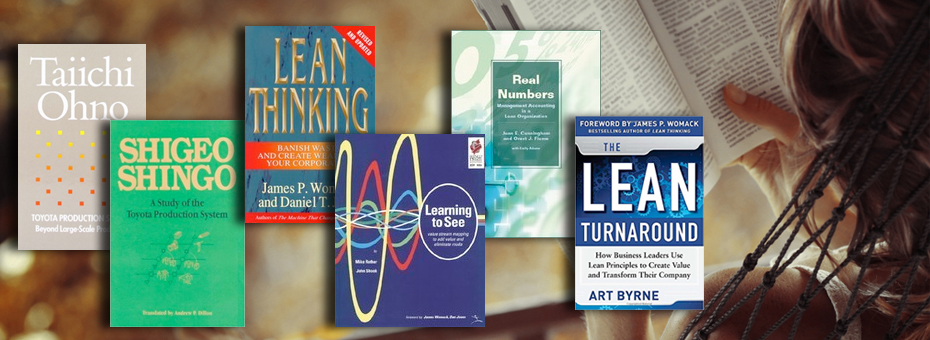The only way to really learn lean is by doing it. That is certainly the way I learned and it is what I tell every person who I work with. The key to this is participating on many kaizen, or continuous improvement, activities—they are the ‘doing’ in the ‘learn-by-doing’ aspect of lean. That said, beginners can benefit enormously by learning about the philosophy that lay behind the thinking of the pioneers of TPS (and lean.) Knowing why something was done, the business and human resources rationale, is more important than what was done. The following books share insights into the philosophy and general approach behind lean, and are the ones I generally recommend to newcomers:
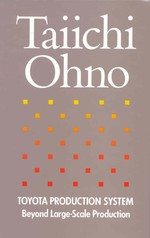 Toyota Production System: Beyond Large Scale Production by Taiichi Ohno.
Toyota Production System: Beyond Large Scale Production by Taiichi Ohno.
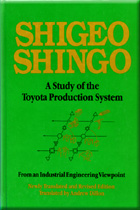 A Study Of The Toyota Production System: From An Industrial Engineering Viewpoint by Shigeo Shingo. It is important to start with the Ohno and Shingo books, as The Toyota Production System is the basis for what we more commonly refer to as lean today. Ohno was the father of TPS; Shingo had a front row seat as an outside consultant and collaborator. As TPS will be the basis of everything we do with lean, is important to get a foundation in what they created and why. Ohno in particular is very good at explaining the whys of the management system he created.
A Study Of The Toyota Production System: From An Industrial Engineering Viewpoint by Shigeo Shingo. It is important to start with the Ohno and Shingo books, as The Toyota Production System is the basis for what we more commonly refer to as lean today. Ohno was the father of TPS; Shingo had a front row seat as an outside consultant and collaborator. As TPS will be the basis of everything we do with lean, is important to get a foundation in what they created and why. Ohno in particular is very good at explaining the whys of the management system he created.
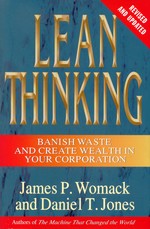 Lean Thinking by Jim Womack and Dan Jones. This 1996 book helped launch the word “lean” into our business vocabulary as a way to think about the Toyota Production System. The authors were part of the original team that coined the phrase at MIT, and this book takes you through the business rationale of starting with the customer and moving all the way through the value stream. The authors were early in recognizing that lean was above all strategic—so this book will help you understand lean in a broad way.
Lean Thinking by Jim Womack and Dan Jones. This 1996 book helped launch the word “lean” into our business vocabulary as a way to think about the Toyota Production System. The authors were part of the original team that coined the phrase at MIT, and this book takes you through the business rationale of starting with the customer and moving all the way through the value stream. The authors were early in recognizing that lean was above all strategic—so this book will help you understand lean in a broad way.
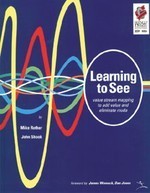 Learning To See by Mike Rother and John Shook. This book will give you the tools and perspective that helps you “see” and then eliminate the waste in your value streams. It takes you step by step through the process of mapping your work and understanding how to improve it.
Learning To See by Mike Rother and John Shook. This book will give you the tools and perspective that helps you “see” and then eliminate the waste in your value streams. It takes you step by step through the process of mapping your work and understanding how to improve it.
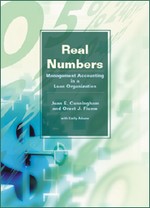 Real Numbers by Jean Cunningham and Orry Fiume (with Emily Adams). This book looks at lean from the finance and accounting point of view. It explains why traditional standard cost accounting and lean are incompatible and more importantly offers an alternative approach that will facilitate your lean turnaround not fight it. This perspective is important as most companies view lean as “some manufacturing thing” and feel they can adopt it without changing anything else in the way they run their business. This of course is impossible. You can’t just put lean on top of a traditional batch system and expect to be successful. Everything must change.
Real Numbers by Jean Cunningham and Orry Fiume (with Emily Adams). This book looks at lean from the finance and accounting point of view. It explains why traditional standard cost accounting and lean are incompatible and more importantly offers an alternative approach that will facilitate your lean turnaround not fight it. This perspective is important as most companies view lean as “some manufacturing thing” and feel they can adopt it without changing anything else in the way they run their business. This of course is impossible. You can’t just put lean on top of a traditional batch system and expect to be successful. Everything must change.
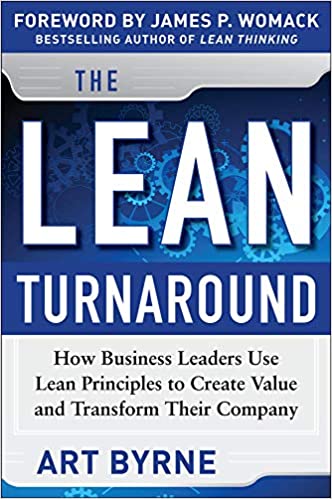 The Lean Turnaround by Art Byrne. This book is aimed at senior executives and emphasizes that lean is the core strategy to turn around any business. It outlines the key management and lean principles that must be present to have a successful lean turnaround. It also walks you through how to implement a lean turnaround and then how to leverage your success in the marketplace.
The Lean Turnaround by Art Byrne. This book is aimed at senior executives and emphasizes that lean is the core strategy to turn around any business. It outlines the key management and lean principles that must be present to have a successful lean turnaround. It also walks you through how to implement a lean turnaround and then how to leverage your success in the marketplace.
